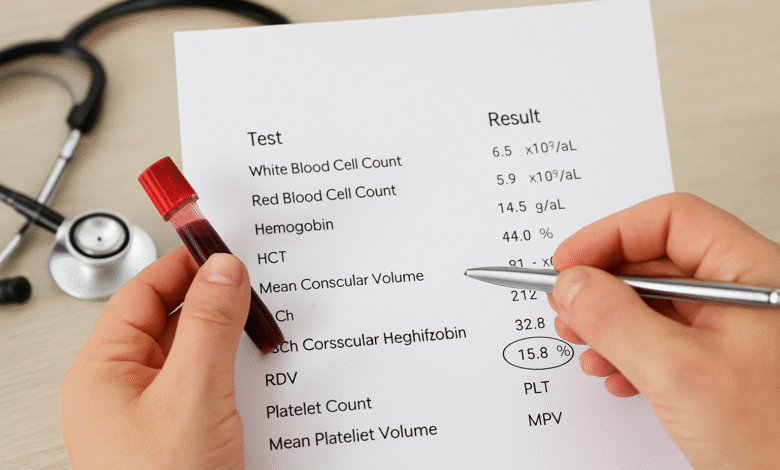What Level of RDW Is Dangerous: Understanding Risks, Causes, and Health Implications

Introduction
When reviewing a complete blood count (CBC), one of the less commonly discussed values is RDW, or Red Cell Distribution Width. While people often focus on hemoglobin, hematocrit, or white blood cell counts, RDW plays a critical role in identifying underlying health conditions. Many patients ask, “What level of RDW is dangerous?” The answer isn’t always simple, as it depends on individual circumstances, causes, and overall health. This article explains RDW levels in detail, what makes them risky, and the health implications you should know.
What Is RDW?
RDW measures the variation in the size of red blood cells in your bloodstream. A healthy person usually has red blood cells of uniform size. When there’s too much variation—some being much larger or smaller than others—the RDW increases. Doctors use this marker to help diagnose anemia and other blood-related issues.
Normal RDW Range
In most laboratories, the normal RDW range is between 11.5% and 14.5%. Values may differ slightly depending on the testing method, but this is generally accepted as the healthy window. Within this range, your red blood cells are relatively consistent in size, supporting efficient oxygen transport.
What Level of RDW Is Dangerous?
An RDW level becomes potentially dangerous when it is significantly higher than 14.5%. A high RDW indicates abnormal red blood cell variation, which can signal serious underlying health problems. However, a low RDW (below 11%) is rare and usually not considered dangerous on its own. The risk lies in elevated RDW values, particularly when combined with abnormal hemoglobin or mean corpuscular volume (MCV) results.
Causes of High RDW
A dangerously high RDW can stem from multiple conditions. Some of the most common causes include:
- Iron deficiency anemia – leading to small and irregularly shaped red blood cells.
- Vitamin B12 or folate deficiency – causing larger red blood cells and uneven distribution.
- Liver disease – which disrupts normal red blood cell production.
- Cardiovascular disease – research links high RDW to increased heart risks.
- Bone marrow disorders – impacting how red blood cells are formed.
Each cause carries different levels of danger, making it essential to evaluate RDW alongside other blood test markers.
Health Risks of a Dangerous RDW Level
When RDW is dangerously high, it often points toward serious health risks:
- Increased risk of heart attack and stroke – High RDW is strongly associated with cardiovascular complications.
- Chronic inflammation – Conditions like rheumatoid arthritis may elevate RDW.
- Poor oxygen delivery – Unevenly sized red blood cells reduce efficiency, leaving tissues oxygen-starved.
- Cancer and chronic disease indicators – Some studies show high RDW correlates with poor prognosis in cancer patients.
In short, RDW is not just a blood test number—it can serve as an early warning sign for major health issues.
RDW and Anemia Connection
Anemia is one of the primary conditions where RDW plays a diagnostic role. If RDW is high but MCV is low, it often suggests iron deficiency anemia. If RDW is high with elevated MCV, it may point toward vitamin B12 or folate deficiency. Understanding this connection helps doctors determine the exact type of anemia and its severity.
When to Worry About RDW
You should be concerned about RDW levels when:
- RDW is consistently above 15%.
- RDW is elevated along with low hemoglobin levels.
- RDW abnormalities occur alongside symptoms like fatigue, dizziness, shortness of breath, or paleness.
A single abnormal RDW value isn’t always dangerous, but persistent high readings require medical investigation.
Symptoms Associated With Abnormal RDW
Abnormal RDW may not always produce direct symptoms, but you might experience signs linked to its underlying cause:
- Persistent tiredness or weakness
- Shortness of breath during simple activities
- Headaches or dizziness
- Chest discomfort in severe cases
- Pale or yellowish skin
These symptoms should prompt a discussion with your healthcare provider.
How Doctors Evaluate RDW
Doctors rarely interpret RDW in isolation. Instead, they review it alongside:
- Hemoglobin levels – measuring oxygen-carrying capacity.
- MCV (Mean Corpuscular Volume) – showing average red blood cell size.
- Other blood indices – including MCH and hematocrit.
This comprehensive approach helps identify whether your RDW indicates a dangerous condition or a temporary imbalance.
Managing High RDW
If your RDW is dangerously high, treatment depends on the root cause:
- Iron or vitamin supplements – for nutritional deficiencies.
- Dietary adjustments – including iron-rich foods like spinach, beans, and lean meat.
- Medication – for chronic diseases affecting red blood cell production.
- Lifestyle improvements – such as managing inflammation, exercising, and quitting smoking.
Addressing the underlying issue usually helps normalize RDW over time.
Can RDW Predict Health Outcomes?
Research increasingly shows that RDW may be a predictive marker of overall health risks. High RDW values have been linked to shorter life expectancy, higher cardiovascular risks, and worse outcomes in hospitalized patients. While not a standalone predictor, it provides valuable insights when combined with other clinical information.
When to See a Doctor
If your blood test shows RDW levels above 15%, especially if paired with symptoms of anemia or heart problems, you should consult a doctor promptly. Early evaluation and treatment can prevent complications and improve long-term health outcomes.
Conclusion
So, what level of RDW is dangerous? Generally, values higher than 14.5% to 15% raise concern and may signal underlying health risks such as anemia, nutrient deficiencies, heart disease, or chronic illness. RDW is not a number to ignore—it can serve as a vital clue about your overall health. By understanding its meaning, recognizing potential causes, and seeking timely medical advice, you can protect your well-being and catch serious conditions early.



